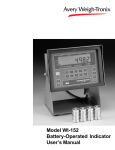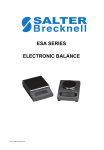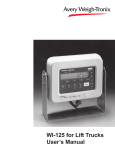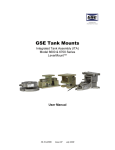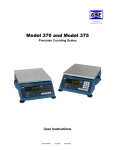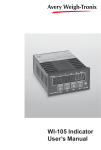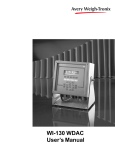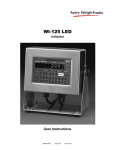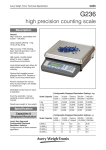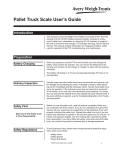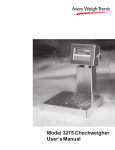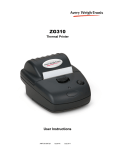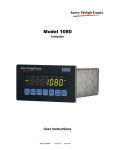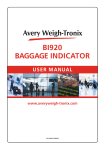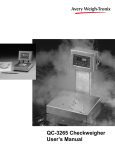Download WI-125 (QTLTSC) Indicator User`s Manual - Avery Weigh
Transcript
WI-125 (QTLTSC) Indicator User's Manual Caution Risk of electrical shock. Do not remove cover. No user serviceable parts inside. Refer servicing to qualified service personnel. Weigh-Tronix reserves the right to change specifications at any time. July 2008 125LTSC_U.indd PN 29608-0013 Issue AP Printed in USA Table of Contents Table of Contents....................................................................................................3 Specifications..........................................................................................................4 Introduction.............................................................................................................5 Operations Mode....................................................................................................5 Keyboard................................................................................................................5 Key Functions...................................................................................................6 Entering Numbers with Arrow Keys..................................................................7 Indicator Operation.................................................................................................8 Powering Up.....................................................................................................8 Annunciators.....................................................................................................8 Operations Menu....................................................................................................9 ID Number Entry...............................................................................................9 Gross/Tare/Net Weighing Operations.............................................................10 Gross Weighing.........................................................................................10 Net Weighing.............................................................................................10 Pushbutton Tare..................................................................................10 Entering a Scroll Tare.......................................................................... 11 Clearing the Active Tare...................................................................... 11 Net Weighing Operation...................................................................... 11 Viewing and Setting Time (Option).................................................................12 Viewing and Setting Date (Option)..................................................................13 Single Accumulator with Counter....................................................................13 Viewing Accumulated Weight and Count........................................................14 Enabling or Disabling Display Backlight..........................................................14 Transmitting Data..................................................................................................15 Indicator Diagnostics............................................................................................16 Daily Inspection Checklist For Lift Truck Scale Users..........................................18 Calculating New Lifting Capacity..........................................................................19 Pages are numbered consecutively beginning with the cover page. WI-125 (QTLTSC) Indicator User's Manual WI-125 Specifications Dimensions: 9.37" W x 6.75" H x 3.75" D (23.8 cm x 17.1 cm x 9.5 cm) Power: 10 to 90 VDC, 300 mA maximum Display: Display Rate: 8 digits, 7-segment LCD, 0.6 inch high with annunciators and backlighting. One, two or five times per second Agencies: NIST Handbook 44, Class III, IIIL, 5,000 divisions COC #95-126 Consumer and Corporate Affairs, Canada) FCC Class A Accuracy : Class III, IIIL; 5,000 divisions Span: ±5.0 ppm/C Zero: ±.066 uV/C (-10 to 40°C) Span: ±10 ppm/C Zero: ±0.13 uV/C (-30 to 60°C) Linearity: ±0.005% of capacity, maximum Repeatability: ±0.005% of capacity, maximum Hysteresis: Weigh bar drive capacity: 0.005% of capacity, maximum Up to eight 350 ohm weigh bars. Environment: -10 to 40°C (14 to 104°F) for HB-44 specs 10 to 90% relative humidity Internal Resolution: 0.25 mV/V = 67,500 counts A to D conversion rate: Analog Range: Capacity: .00001 to 999999, programmable to any number between these limits. Divisions: .0001 to 20000, programmable to any division size between these limits. Push Button Zero Range: Tare: Motion Detection Window: Automatic Zero Tracking: 30 times per second -0.14 to +3.5 mV/V 0 to ±100% of capacity; programmable independent positive and negative limits; unit will not allow zeroing beyond capacity. The unit may be configured to have pushbutton tare which can function as a scroll tare register. Pushbutton tare and scroll tare may tare only positive gross weights up to the capacity of the unit. Scroll tare allows numeric entry of a tare value using two keys to enter the value. Programmable from 0 to 999999 divisions, decimal entries are accepted. Window: Programmable from 0 to 999999 divisions, decimal entries are accepted. Net Mode Tracking: Rate: Starting Delay: Linearity: Second order correction provides smooth curve fit through three points--zero, linearity, span. Angle Compensation: VIBRATION COMPENSATION Analog Low Pass Filter: Software Low Pass Filter: May be enabled or disabled. 0.2 division per second 2 seconds Compensates for pitch and/or roll out-of-level weighing. Two section with .10 second time constant for low power analog and .06 second time constant for standard analog. One section with .05 second time constant. WI-125 (QTLTSC) Indicator User's Manual Introduction The WI-125 is a weight indicator which may be used with Lift Truck Systems. The indicator is powered by a DC power source of 10 to 90 volts. This set of instructions is divided into the following sections: •Introduction •Operations Mode •Keyboard •Indicator Operation •Operations Menu •Transmitting Data •Indicator Diagnostics Operations Mode Operations mode contains all normal weighing operations. In this mode you can view or set the following parameters if the unit is so configured: • pushbutton tare • time • date • backlight Time, date and backlight can be secured behind a security code. Parameters secured by the code number can be viewed but not changed unless you enter the security code. Keyboard The keyboard consists of 7 keys. Five keys, or buttons, provide all the basic weighing functions: • • • • • Tare Gross/Net Zero Print Units The other keys are used to access the menus for purposes of accessing information, testing the indicator, and configuration. The keyboard is shown in Figure 1. Figure 1 WI-125 Keyboard WI-125 (QTLTSC) Indicator User's Manual Key Functions Key Functions Enters a pushbutton tare in gross/net operation. This key's factory default is OFF and it must be enabled for use. Accesses the gross weighing mode from any other function and activates the net weighing mode if a tare is active. Zeros the scale in gross or net weigh mode. This button also clears scrolled digits on the display before they are accepted. Sends a print command and is used to select menu items. Used to access menus and move among choices in a menu. Changes the unit of measure during operations mode and moves a digit inserted with the ↑ key one space to the left. The factory default for this key is set for lbs only. Lets you scroll numerical values. WI-125 (QTLTSC) Indicator User's Manual Entering Numbers with Arrow Keys If at any time you enter an incorrect number, press CLEAR to delete the number, then re-key. The arrow keys are used to enter numbers. Refer to this section when you need to enter a number or numbers. Example: To key in the number 603 Press the ↑ key repeatedly until the 6 appears on the display. Press the ← key once to move the 6 one space to the left. Press the ↑ key until the 0 appears. Press the ← key once to move the 60 one space to the left. Press the ↑ key until 3 appears. The decimal appears after the 9 as you scroll through the numbers with the ↑ key. After the decimal appears, press the ← key once, then enter the next digit of your number. WI-125 (QTLTSC) Indicator User's Manual Indicator Operation Powering Up The unit will power up in gross or net weighing mode, depending on what mode the unit was in when last turned off. The indicator display (see figure 2) tells you the status of the indicator through the illumination of annunciators. The annunciators are small black arrows pointing to the different labels around the display face. No annunciators are lit while motion is detected. Figure 2 Indicator Display Annunciators Gross - Illuminates when indicator is in gross weighing mode. Net - Illuminates when a tare is in effect and the indicator is in net weighing mode. Zero - Illuminates when the scale is within ±1/4 division of zero. Print - Illuminates when the print key is pressed and data is transmitted. lb, kg - Illuminates the active unit of measure in weighing mode. WI-125 (QTLTSC) Indicator User's Manual Operations Menu Your unit is configured to display some or all of the following functions: pushbutton tare, time, and date. These can be viewed and changed if allowed by the security code. This manual assumes the unit is configured to allow full access to all functions. You can disable unneeded options. Instructions are in the Service Manual. Below is a flowchart and general instructions for moving around the operations mode menu. Figure 3 Operations Menu Diagram Press MENU to go right in the diagram. Press and hold MENU to go left in the diagram. Press SELECT to select new choice and to go up and down in the diagram. Press G/N at any time to save changes and return to gross/net weighing mode. ID Number Entry You may enter an ID number of up to 8 digits in length. The ID number may include any combination of the numbers 0 through 9, a dash, and a decimal point. 1. From gross weighing mode, press MENU repeatedly. . . id. is displayed. 2. Press SELECT . . . The current ID number is displayed. 3. With the current ID number displayed, enter a numerical value for your ID number. Refer to the section Entering Numbers with Arrow Keys. . . The new ID number is displayed. 4. After your new ID number has been displayed, press SELECT. . . id. is displayed. 5. Press G/N to return to the weighing mode. . . WI-125 (QTLTSC) Indicator User's Manual Display returns to gross or net mode. Gross/Tare/Net Weighing Operations Gross Weighing To perform gross/net weighing operations, follow these steps: 1. Power up the indicator. 2. If the unit is not in gross mode, press the G/N key once to get to gross mode. 3. Make sure the forks of the lift truck are off the ground and empty, then zero the scale by pressing the ZERO key. 4. Select unit of measure by pressing the UNITS button. 5. Place weight on the scale. Net Weighing Pushbutton Tare 1. With the forks off the ground, the scale empty and the indicator powered up in gross mode, zero the scale by pressing the ZERO key. 2. Place the weight to be tared on the scale. 3. Press the TARE key on the indicator. 4. Add more weight to the scale. 5. View the gross weight by pressing the G/N button. 6. Press the G/N key again to see net weight. 10 WI-125 (QTLTSC) Indicator User's Manual Indicator powers up in gross or net mode. The annunciator illuminates next to gross. See Figure 2 No weight is displayed and the zero annunciator illuminates. See Figure 2. The units annunciator will point to the chosen unit of measure. Gross weight is displayed. No weight is displayed and the zero annunciator illuminates. The weight of the object is displayed. The weight is tared, the display reads zero and the net annunciator illuminates. Net weight is displayed. Gross weight is displayed and the gross annunciator illuminates. Net weight is displayed and the net annunciator illuminates. Entering a Scroll Tare 1. From gross/net weighing mode, press the MENU key. 2. Briefly press the SELECT key. You may view the current or active tare value at any time during a weighing process. From gross or net weighing mode, press MENU then SELECT. If a tare value is in use, it will be displayed. Press G/N to return to gross/net weighing mode. Refer to Operations Menu on previous page. Clearing the Active Tare 3. With the current tare value displayed, enter a numerical value for your tare. Refer to the section Entering Numbers with Arrow Keys. Then, press the SELECT key. 4. Press G/N to return to gross/net weighing mode. no tArE or the current tare value is displayed. You can toggle between no tArE and the current tare value by pressing the MENU key. New tare value is displayed, then tArE is displayed. Display returns to gross or net mode. There are two ways to remove the current or active tare weight. 1. Remove all weight from the scale and press TARE. 2A.With the gross or net annunciator illuminated, press MENU, then press CLEAR. 2B.Press the G/N key. Net Weighing Operation tArE is displayed. 1. After a tare is established, place the indicator in net mode by pressing the G/N key. 2. Place material to be weighed in the tared container on the scale. WI-125 (QTLTSC) Indicator User's Manual Tare register is cleared, scale returns to gross mode and no weight is displayed. tArE is displayed, then no tArE is displayed. Gross weight is displayed and no tare is active. Net annunciator illuminates. Zero weight will be displayed with the container on the scale. Net weight of material is displayed. 11 Viewing and Setting Time (OPTION) 1. From gross/net weighing mode, press MENU repeatedly until . . . 2. Press SELECT. If you enter an incorrect digit, press the ZERO/CLEAR key to clear the display one digit at a time. 3. To set the 12 hour clock, press the ↑ key to delete the old time value. Hour is displayed. In the 12 hour clock configuration you will see time displayed as hours, minutes and A for A.M. or P for P.M. (09.40 A). In the 24 hour clock, you will see hours, minutes and seconds (09.40.38). 0 A or 0 P is displayed. The A is for A.M., P for P.M. Key in the time as hh mm ss. Refer to the section Entering Numbers with Arrow Keys. Press the TARE key to toggle between AM & PM after entering at least one digit and before pressing SELECT. 4. To set the 24 hour clock, key in time as hh mm ss. 5. After the clock is set, press SELECT to start the clock and return to operations mode menu, Hour is displayed, and the clock begins at the new time setting. 12 or press G/N to return to gross/net weighing mode. WI-125 (QTLTSC) Indicator User's Manual Display returns to gross/net mode and the clock begins at the new time setting. Viewing and Setting the Date (OPTION) 1. From gross/net weighing mode, press MENU repeatedly until. . . dAY is displayed. 2. Press SELECT. Depending on the configuration of your indicator, you will see the date displayed in one of three ways: • month-day-year, • day-month-year, or • year-month-day. If you enter an incorrect digit, press the ZERO/CLEAR key to clear the display one digit at a time. 3. To change the date, key in the new data. Refer to the section Entering Numbers with Arrow Keys. 4. Press SELECT to return to the operations mode menu, or press G/N to return to gross/net weighing mode. The old date is replaced with the new date. The date is accepted and dAY is displayed. The date is accepted and the display returns to gross/net mode. Single Accumulator with Counter There is a single channel accumulator in the indicator. The accumulator will add the displayed weights automatically and print individual weights and totals on command. Weighing and Printing 1. Weigh load. . . Indicator displays weight. 2. Press PRINT. . . Weight is printed. Factory default configuration is Accumulator and Counter off. Printing the accumulated weight and count can be accomplished at any time during the weighing process; however, printing these values automatically clears them from memory! So take care to print the accumulated values only after you have made all the necessary weighments. A print/add function will occur if you have autoprint enabled or if a remote Print command is received by the indicator. 3. For each additional load weighed, press PRINT. . . Each weight is printed individually and the weight is totalled automatically within the indicator. 4. After the last load has been weighed and printed, press MENU, then TARE. . . G G G Total Count The total weight and count are printed and cleared from memory. 210 lb 200 lb 200 lb 610 lb 3 Sample printout WI-125 (QTLTSC) Indicator User's Manual 13 Viewing Accumulated Weight and Count GROSS may be pressed at any time during viewing to return to weighing mode. Enabling or Disabling Display Backlight 1. With weight displayed, press MENU until. . . ACC is displayed. 2. Press PRINT/SELECT. . . Total weight of all loads is displayed. 3. Press PRINT/SELECT to toggle back to ACC. . . ACC is displayed. 4. Press MENU once. . . count is displayed. 5. Press PRINT/SELECT. . . Total number of loads is displayed. 6. Press PRINT/SELECT to toggle back to count. . . count is redisplayed. 7. Press G/N to return to weighing mode. . . Current weight is displayed. 1. From gross/net weighing mode, press MENU repeatedly until . . . Light is displayed. 2. Press SELECT. 3. Press MENU to toggle between enabled or disabled. 4. Press SELECT to return to the operations mode menu 14 or press G/N to return to gross/net weighing mode. WI-125 (QTLTSC) Indicator User's Manual ENABLED or diSAbLEd is displayed. Configuration choices made during setup of this unit will determine if the backlight is on constantly or if it varies according to ambient light levels. Refer to the Service Manual. The light selection is accepted and Light is displayed. The light selection is accepted and the display returns to gross/net mode. Transmitting Data Serial Port RS-232 output is available for data transmission. The PRINT annunciator (See Figure 2) will illuminate while data is transmitted and sent to the printer. A default printout will list gross weight only (see Figure 4). Figure 4 Sample WI-125 Default Printout Printouts can also be configured to include a header as well as the tare and net weights. See Figure 5 as an example of a possible printout. Figure 5 Possible Print Configuration The default settings for serial output are: Busy Baud Parity Stops WI-125 (QTLTSC) Indicator User's Manual Disabled 9600 Clear 1 15 Indicator Diagnostics The test mode is used to test various functions of the WI-125. The test menu is shown in Figure 6. Instructions for using the test menu are found below. Figure 6 Test Menu 1. Enter the test mode from gross/net operation by pressing and holding the MENU key until tESt is displayed. SEALEd or unSEALEd is displayed briefly while you hold the key. 2. Move to the right through the menu selections by pressing MENU briefly. Move to the left through the menu selections by pressing MENU for 1 second or hold down for continuous scrolling. 3. To move down a level in the hierarchy, press SELECT. Anytime you wish to get to the next higher level in the hierarchy, press and hold SELECT for approximately 1.5 seconds or press SELECT whenever End is displayed. 4. Press MENU to toggle between choices. 5. Press G/N to return to gross weighing operation at any time. 16 WI-125 (QTLTSC) Indicator User's Manual Below are the specific directions and explanations for the items you see in the test menu. VERSION — Under version are the Weigh-Tronix part number and revision number for the software found in your machine. WeighTronix part numbers are divided into two parts: the prefix and the dash number. DISPLAY — With diSPLAY displayed, press SELECT and the bottom row of annunciators turns on. Press SELECT again and a dynamic test is run. Press MENU to stop the dynamic test or consecutively press MENU to step through the display test routine. Press SELECT when the dynamic test is active to return the unit to diSPLAY. BUTTONS — With buttonS displayed, press SELECT and an underscore will appear on the screen. Press any key except MENU to check for proper key functioning. After testing the buttons, press MENU to return to the display. A to D — Displays the analog to digital counts. The span is normally 20,000 counts per millivolt per volt. With a calibrator at zero millivolts per volt, the displayed value should be between ‑200 and +200. ANGLE — Displays pitch and roll confirming that the angle sensors are functional. SERIAL — Tells you if the serial output is ready or busy. A jumper connecting pins 4 and 8 of the serial port will cause rEAdY to be displayed. Pressing the MENU key puts LOOP or no LOOP on the display. With pins 2 and 3 connected, LOOP is displayed. With them disconnected, no LOOP is displayed. WI-125 (QTLTSC) Indicator User's Manual 17 Daily Inspection Checklist For Lift Truck Scale Users ❑ Check scale carriage for loose, worn, bent, or broken components. ❑ Inspect forks for damage. ❑ Check locking pins on forks for proper function. ❑ Inspect cables from the junction box to Weigh Bars for wear. ❑ Inspect retractable cable for pinched, rubbed, stretched, or damaged areas. ❑ Inspect power cable for nicks or cuts. ❑ Make sure power cable is routed out of harms way. Fasten periodically to eliminate potential problems. ❑ Tighten cable connections at indicator and summing box if necessary. ❑ Inspect cable clamps and cable ties to be sure all cable attachments are secure. ❑ Inspect digital indicator mounting bracket, isolation mounts and hardware for loose or cracked parts. ❑ Check to make sure the junction box cover/shielf is fastened. ❑ Tighten bottom clamps on scale carriage if necessary. Raise carriage and visually inspect. ❑ Check and adjust the lift chain so the heel of the forks have ½" to 1" of clearance from the floor when the carriage is down and the mast is vertical. 18 WI-125 (QTLTSC) Indicator User's Manual Calculating New Lift Capacity You must have the ID plate on the lift truck updated stating the new lifting capacity and center of gravity information. This requirement is per OSHA rules and regulations. A calculation formula is provided below. It is the customer’s responsibility to contact their lift truck manufacturer / distributor with this information to obtain the new ID plate. The QTLTSC lift truck scale comes in ITA Class II (16” high, 5,000 lb) and ITA Class III (20” high, 5,000 and 10,000 lb) and Class IV (25” high, 10,000 lb and 16,000 lb) models. Each class comes in several widths for cleat type carriages. Measure the height and width of the lift truck carriage. Select from the table below the appropriate width that best meets the dimensions of the lift truck carriage. Use the weights, dimensions and the following formula to calculate the net lifting capacity of your lift truck with a scale attached. Refer to Figure 7. Class II A =Truck basic capacity, pounds B =Inches from front wheel center line to fork face C =Inches from fork face to truck rating point (usually 24") D =Weight of the scale in pounds E =Inches from front wheel center line to carriage face F =Inches from carriage face to scale center of gravity (CG) G =J + K (Inches from carriage face to rear face of load) H =Inches from fork face to new truck rating point J = Thickness of fork K =Thickness of scale L = ½ the height of the scale or the Vertical Center of Gravity (VCG) Class III Class IV Average loss in lifting capacity for a QuickTach lift truck scale is 12 to 14%. WI-125 (QTLTSC) Indicator User's Manual 19 Class II 5,000 lb Models Scale P/N 48196-0094 48196-0011 48196-0029 48196-0102 48196-0037 48196-0110 48196-0128 48196-0045 Width 30.0" 32.0" 34.0" 36.0" 37.0" 38.0" 40.0" 42.0" Weight "D" 373 lb 381 lb 389 lb 410 lb 413 lb 418 lb 438 lb 446 lb Class III 10,000 lb Models Scale P/N 51857-0031 51857-0056 51857-0072 51857-0106 51857-0114 51857-0155 51857-0197 51857-0239 Width 40.0" 42.0" 44.0" 47.0" 48.0" 52.0" 56.0" 60.0" Weight "D" 725 780 795 855 865 935 1005 1030 DIM "F" 2.0" 2.0" 2.0" 2.0" 2.0" 2.0" 2.0" 2.0" Scale P/N 51856-0016 51856-0024 51856-0032 51856-0057 51856-0073 51856-0099 51856-0115 51856-0131 DIM "F" 2.75" 2.75" 2.75" 2.75" 2.75" 2.75" 2.75" 2.75" 20 Width 38.0" 40.0" 42.0" 44.0" 46.0" 48.0" 50.0" 52.0" 54.0" 56.0" 58.0" 60.0" 62.0" 64.0" 66.0" 68.0" 70.0" 72.0" Weight "D" 1068 1092 1154 1178 1239 1263 1338 1362 1437 1461 1484 1592 1616 1639 1747 1771 1794 1812 DIM "F" 3.06" 3.06" 3.06" 3.06" 3.06" 3.06" 3.06" 3.06" 3.06" 3.06" 3.06" 3.06" 3.06" 3.06" 3.06" 3.06" 3.06" 3.06" Class III 5,000 lb Models Width 36.0" 37.0" 38.0" 40.0" 42.0" 44.0" 46.0" 48.0" DIM "K" 5.50" 5.50" 5.50" 5.50" 5.50" 5.50" 5.50" 5.50" Scale P/N 53924-0010 53924-0036 53924-0051 53924-0077 53924-0093 53924-0119 53924-0135 53924-0150 53924-0176 53924-0192 53924-0218 53924-0234 Class IV 16,000 lb Models Scale P/N 53425-0014 53425-0030 53425-0055 53425-0071 53425-0097 53425-0113 53425-0139 53425-0154 53425-0170 53425-0196 53425-0212 53425-0238 53425-0253 53425-0279 53425-0295 53425-0311 53425-0337 53425-0352 DIM "K 4.0 4.0 4.0 4.0 4.0 4.0 4.0 4.0 Weight "D" 520 530 540 580 635 685 700 720 DIM "F" 2.00" 2.00" 2.00" 2.00" 2.00" 2.00" 2.00" 2.00" DIM "K" 4.00" 4.00" 4.00" 4.00" 4.00" 4.00" 4.00" 4.00" Class IV 10,000 lb Models Width 38.0" 40.0" 42.0" 44.0" 46.0" 48.0" 50.0" 52.0" 54.0" 56.0" 58.0" 60.0" DIM "K" 6.13" 6.13" 6.13" 6.13" 6.13" 6.13" 6.13" 6.13" 6.13" 6.13" 6.13" 6.13" 6.13" 6.13" 6.13" 6.13" 6.13" 6.13" WI-125 (QTLTSC) Indicator User's Manual Weight "D" 920 941 1007 1028 1093 1114 1179 1200 1266 1287 1306 1322 DIM "F" 2.75" 2.75" 2.75" 2.75" 2.75" 2.75" 2.75" 2.75" 2.75" 2.75" 2.75" 2.75" DIM "K" 5.50" 5.50" 5.50" 5.50" 5.50" 5.50" 5.50" 5.50" 5.50" 5.50" 5.50" 5.50" Lift truck with no scale Lift truck with scale Figure 7 Recalculating Lift Truck Capacity WI-125 (QTLTSC) Indicator User's Manual 21 22 WI-125 (QTLTSC) Indicator User's Manual Avery Weigh-Tronix USA 1000 Armstrong Dr. Fairmont MN 56031 USA Tel: 507-238-4461 Fax: 507-238-4195 Email: [email protected] www.wtxweb.com Avery Weigh-Tronix UK Foundry Lane, Smethwick, West Midlands, England B66 2LP Tel: +44 (0) 8453 66 77 88 Fax: +44 (0)121 224 8183 Email: [email protected] www.averyweigh-tronix.com Weigh Bar® is a registered trademark of Weigh-Tronix Inc.




























